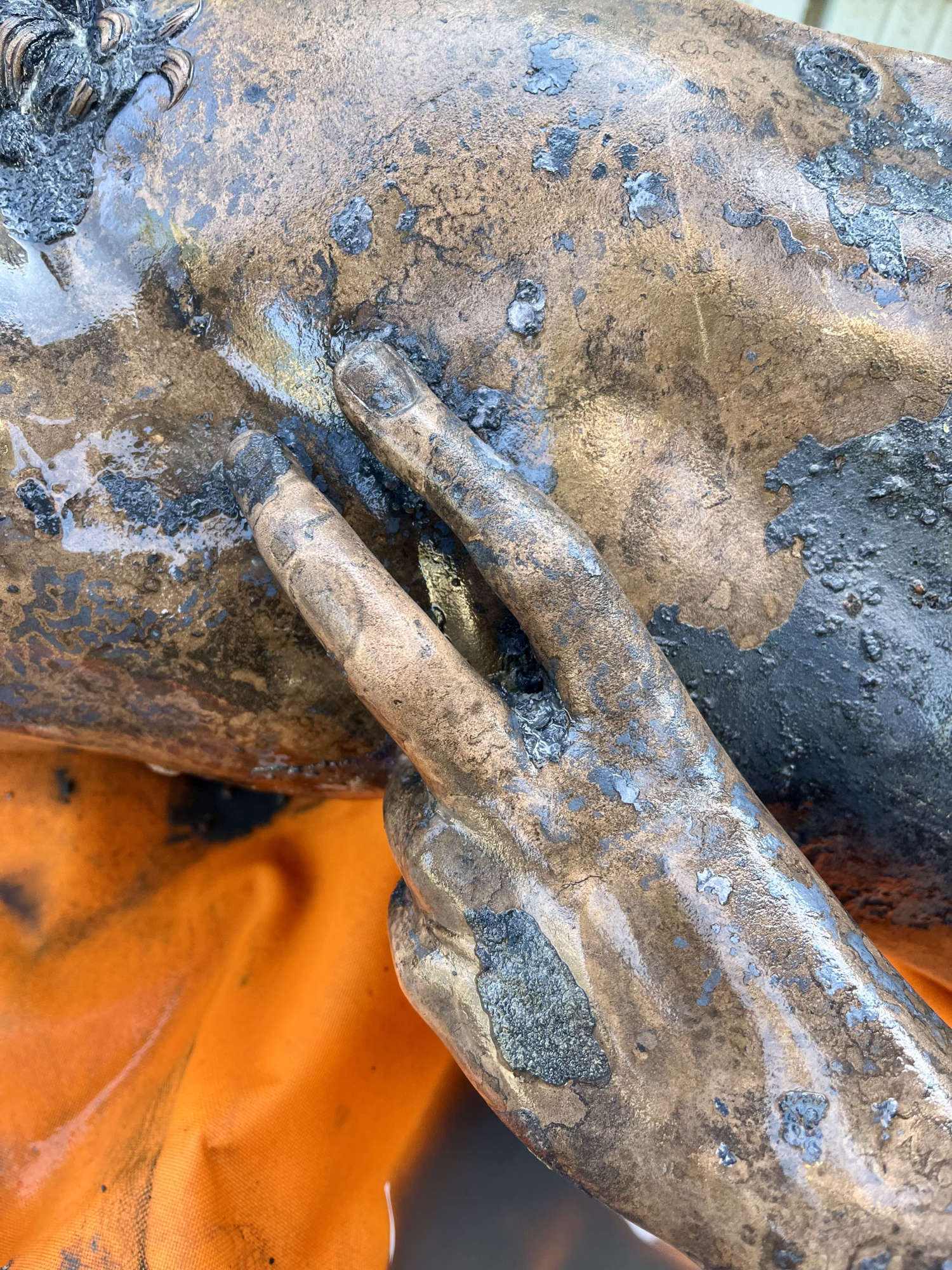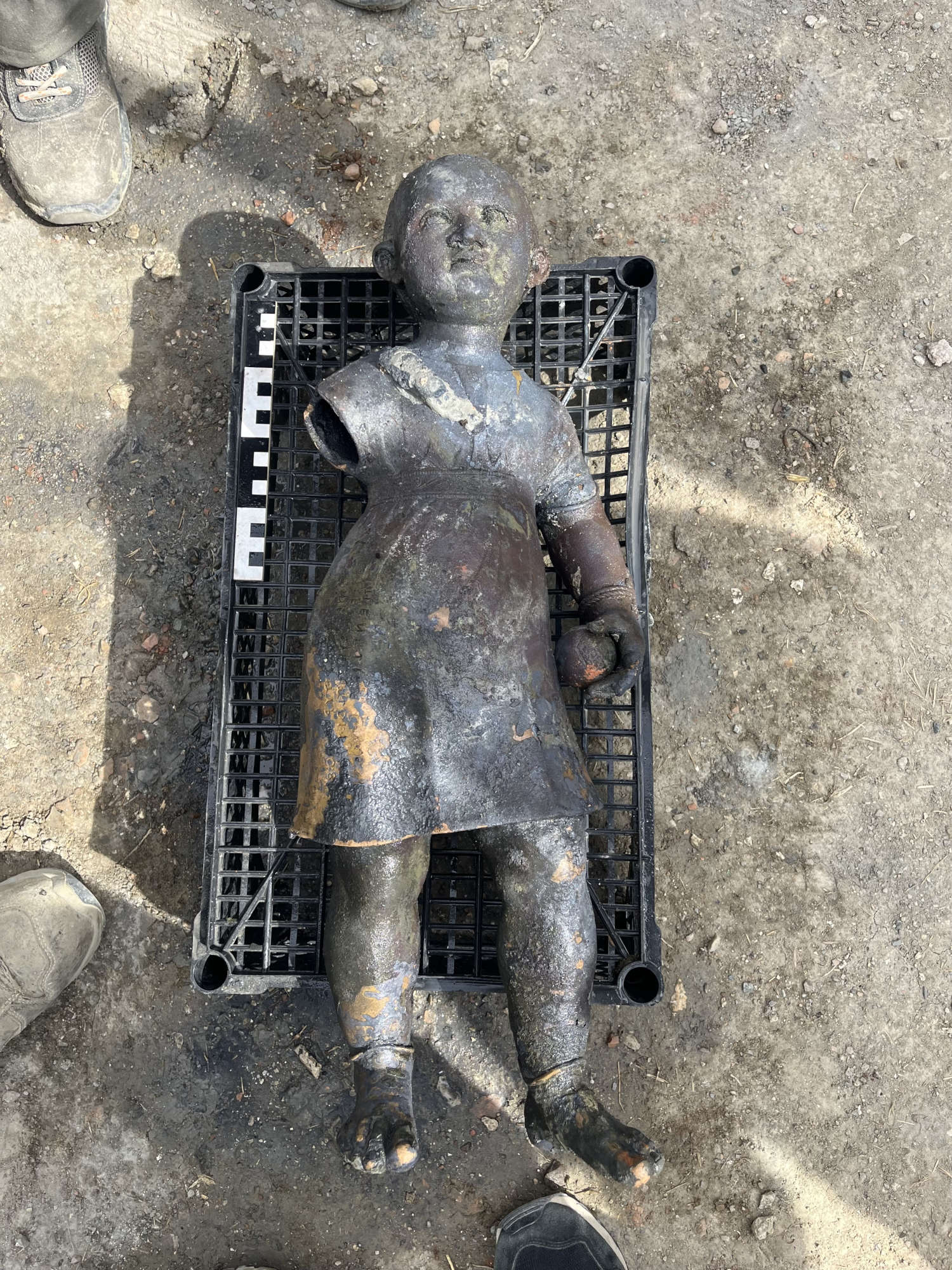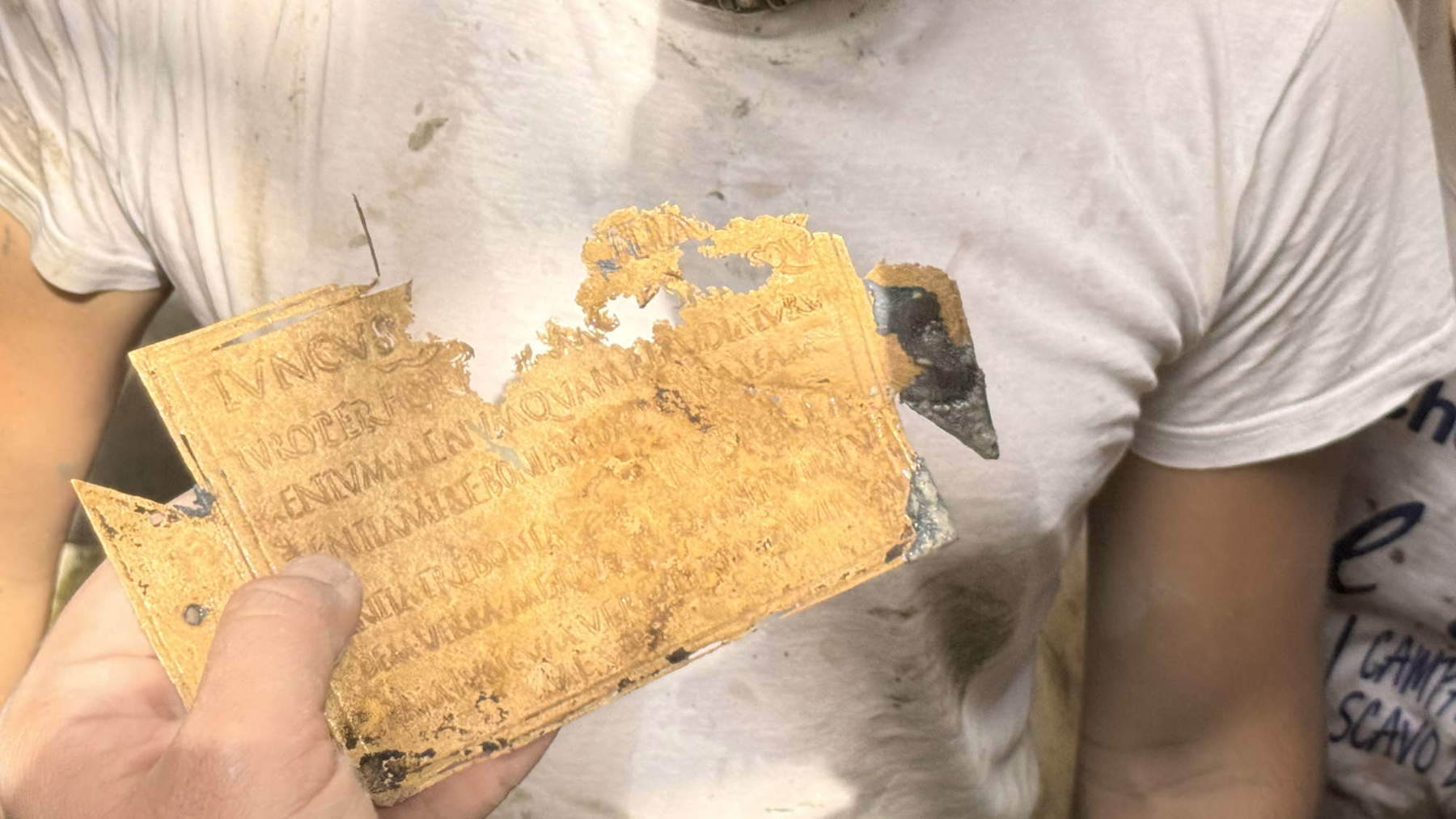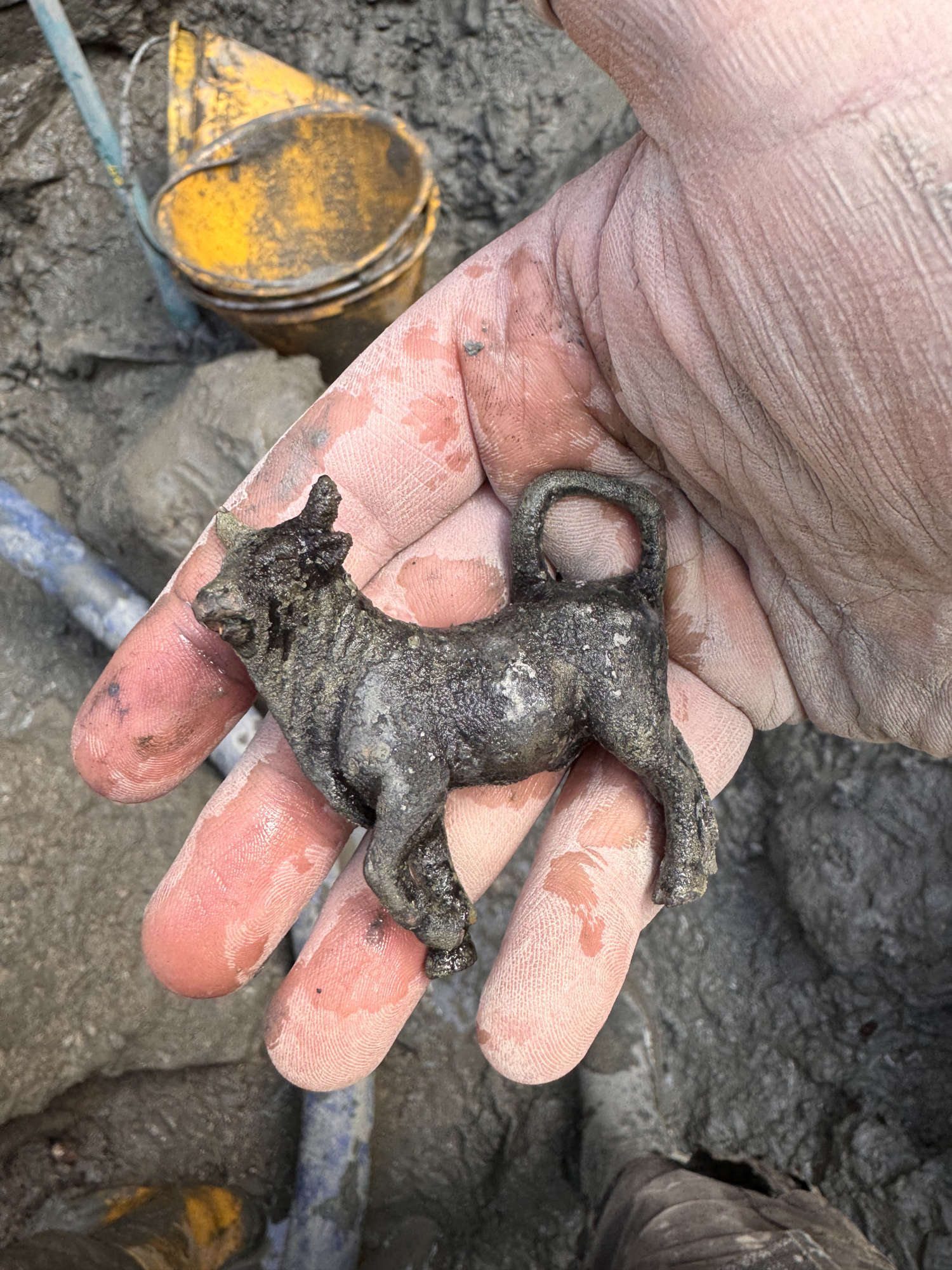Extraordinary discoveries in San Casciano dei Bagni: thermal sanctuary reveals new secrets
In San Casciano dei Bagni, a small town in the province of Siena known for its hot springs and the exceptional discovery of a deposit of ancient bronzes unearthed in 2022, the year 2024 also closes with an extraordinary archaeological revelation. The Etruscan and Roman sanctuary of Bagno Grande continues to offer a unique window into the history and worship of sacred waters, and just today the results of the recent excavation campaign were announced in the presence of Culture Minister Alessandro Giuli, Tuscany Region President Eugenio Giani and other institutional and cultural figures. The event, which included the screening of a preview of Rai Storia Italia’s documentary , Journey into Beauty, revealed new aspects of a place that has combined faith, nature and medicine for millennia.
The excavation of the Bagno Grande of San Casciano dei Bagni is under excavation concession to the Municipality of San Casciano dei Bagni by the General Directorate of Archaeology, Fine Arts and Landscape and was created in collaboration with the ABAP Superintendence for the provinces of Siena, Grosseto and Arezzo and the scientific coordination of the University for Foreigners of Siena. Conservation and restoration work takes place in collaboration with the Central Institute for Restoration.
“With immense pleasure, at the conclusion of the latest excavation campaign, we share another chapter in the extraordinary history of Bagno Grande, which has helped to reinforce the importance and centrality of the Etruscan-Roman sanctuary,” said Gabriele Nannetti, superintendent of Archaeology, Fine Arts and Landscape for the provinces of Siena, Grosseto and Arezzo. “The recent discoveries are also an additional incentive for the planning, which has already begun, of the new museum and the first lot of the San Casciano Archaeological Park. In this scenario, the Superintendence is working to better manage the timetable of the interventions to be carried out with the resources made available by the Ministry of Culture, according to a virtuous model of collaboration and institutional support, already widely tested, with the Municipality, the General Directorates, the Central Institute for Restoration and the University for Foreigners of Siena.”






The 2024 discoveries: from the temenos to the heart of the cult
Between June and October 2024, expanded excavations allowed the exploration of a larger portion of the temenos, the sacred enclosure that enclosed the sanctuary, and brought to light structures from Etruscan and Roman times. Prominent among these is the perimeter wall that enclosed the sacred space, including the large thermal pool and buildings dedicated to worship.
The most fascinating discovery concerns the oldest basin, dated to the 3rd century B.C., when a structure made of travertine blocks bordered the sacred hot spring. This pool, rebuilt during the reigns of the emperors Tiberius and Claudius, testifies to the importance of the site even in imperial times. A legend may have been at the origin of the architectural renovation: the fall of lightning, considered a divine prodigy, supposedly called for a rededication of the area.
Outside the temple, archaeological layers rich in objects telling of cultic practices have been found:oil lamps, glass unguentaries, votive bronzes , and numerous votive offerings, including anatomical figurines in painted terracotta and gold leaf. However, it is inside the sacred pool that the most extraordinary finds are concentrated, protected by the clay mud and thermal waters that have preserved them for centuries.






Statues, coins and inscriptions: the language of the sacred
Excavations in 2024 unearthed an impressive number of votive offerings, including four new bronze statues. These artifacts depict votive limbs such as arms and legs, often accompanied by inscriptions, alongside ritual tools such as an elegant oil lamp and a small bronze bull. The statues evoke the agricultural and pastoral world of antiquity, which has already been represented in other artifacts from Bagno Grande.
Alongside the bronzes, coins form a central element of the votive deposit: with more than 10,000 specimens, the site offers an exceptional overview of monetary circulation between the Republican and Imperial ages. These are joined by precious materials such as a gold crown and ring, gems, amber, and Roman aureas, testifying to the high symbolic value of the offerings.
Inscriptions discovered in 2024 further enrich the context of the shrine. Engraved in both Etruscan and Latin, they mention local deities and offer details about religious practices. Prominent among the dedications is one to the Hot Spring, called Flere Havens in Etruscan, alongside oaths to Fortuna and the Emperor’s Genius.
One find of particular note is a statue of a naked male body, split in half by a clean cut. Dedicated to the Hot Spring by a certain Gaius Roscio, this figure could symbolize the healing of the body part represented in bronze.






Bronze snakes
The site has also returned a unique repertoire of organic materials, including thousands of egg fragments, many of them whole and preserved with the yolk visible. These elements, symbolic of fertility and rebirth, alternate with pine cones, intertwined branches, and upright wooden trunks, testifying to the importance of connections between nature and sacredness.
Among the most fascinating finds emerge bronze snakes, placed at the base of large logs within the stratigraphic deposit. Varying in size from small specimens to a snake of over 90 cm, the artifacts represent the agatodemon snake, a protective figure linked to spring and divinatory practices. Precisely the 90-centimeter specimen, almost the mensura honorata, the perfect size of three Roman feet, a bearded and horned snake, represents, in all probability, the largest to date found agathodemon snake: bronze ones are known from the National Archaeological Museum in Naples and the British Museum in London, the protector of the spring and the holder of a key role in divinatory practices, as can be seen in many other ancient Mediterranean contexts, but none of this size.






San Casciano as a model of conservation and enhancement
The excavation of Bagno Grande, managed under concession by the Municipality of San Casciano dei Bagni with the coordination of the University for Foreigners of Siena and the support of the Ministry of Culture, represents a virtuous example of interdisciplinary collaboration. The 2024 campaign involved more than 80 archaeology students from universities around the world, joined by an international team of more than 90 specialists.
Conservation and restoration activities, conducted in collaboration with the Central Institute for Restoration, ensure the protection of the structures and artifacts that have emerged. The project enjoys the support of private funders such as the Vaseppi Trust and Friends of Florence, as well as contributions from the Municipality of San Casciano and entities such as Group E and Iren. A key role is also played by the local Eutyche Avidiena Archaeological Association, which has organized archaeological walks and guided tours for more than 5,000 people, helping to spread knowledge about the site.
The future of Bagno Grande: a museum and an archaeological park
Future plans include the creation of the National Archaeological Museum of San Casciano dei Bagni, which will be housed in the Palazzo dell’Arcipretura and will house the artifacts found in Bagno Grande. A Thermal Archaeological Park will be built next to the museum, designed to further enhance this extraordinary site.
The new discoveries from the Bagno Grande will also be featured in the episode of Italy, Journey into Beauty, to be aired on Rai Storia in February 2025. Entitled Beyond the Bronze, the excavation of San Casciano dei Bagni, the documentary, signed by Brigida Gullo and Eugenio Farioli Vecchioli, will recount the charm of a place where the sacred meets natural beauty and the genius loci is manifested in the warm waters and their gifts.
San Casciano dei Bagni, already famous for its hot springs, thus confirms itself as a point of reference for archaeology, capable of offering a unique look at the spiritual traditions and daily life of antiquity. An extraordinary example of how the past can dialogue with the present, enriching our understanding of history and man’s relationship with the divine.
Statements
“St. Casciano is a place dear to me,” says Culture Minister Alessandro Giuli. “Here I came up with the idea of an Olivetti plan for culture, that is, to establish a link between villages, suburbs, cities. This one of the San Casciano dei Bagni excavations is a project that was born in an extraordinary community, with findings that lead the MiC to strongly support it, so that the archaeological area and the goods found in it can be made the most of and the museum structure takes shape as quickly as possible. St. Casciano’s is an absolutely important project for the MiC.”
“The community of San Casciano,” says the mayor of San Casciano dei Bagni, Agnese Carletti, “has invested and is investing so much in this project. Today, having all the actors here is a great satisfaction with a view to soon seeing the realization of the museum, park and university hub on which we have been working for years now and which will breathe new life into this municipality. The hope is that the good and prophetic spirit of the spring embodied in the bronze serpent found this summer can help us realize everything as quickly as possible.”
For Eugenio Giani, President of the Tuscany Region, “San Casciano dei Bagni exemplifies the power of culture. The theme that emerges clearly here is that of how culture is capable of revitalizing small towns. San Casciano dei Bagni can become an example for everyone of perspective for the future, a true emblem of widespread Tuscany. Today’s day is important to give concreteness and this, with the synergy between all the institutions that will be fixed starting with the statute of the Foundation that will be a model between the Municipality, the Region of Tuscany and the Ministry, to enhance this priceless treasure, to manage the new museum and more generally to give centrality to culture, a founding element of our identity. Reviving knowledge of the Etruscan civilization with its modern elements, such as the central role of women in society, is a crucial issue for our cultural future.”
“The extraordinary participation in today’s presentation and the presence of the minister are a sign of the great support that the administration is giving and will give to this archaeological project,” says MIC Protection Department Head Luigi La Rocca. “Here, in San Casciano dei Bagni, a good practice of collaboration between many public and private entities has developed, and out of this has come a project that the Minister of Culture has financed and supported. A project that is based on scientific foundations, on a cohesive and multidisciplinary group of archaeologists, and on a local community that is present and participatory. The dissemination of the knowledge that is coming out of the archaeological research is a fundamental point of the project, along with the valorization of the objects. The findings convey to us an ancient but current message, the connection between health and the need to heal and faith, between the scientific method and ritual practices, all linked by the thermomineral water of Bagno Grande. The data tell us of a changing world, the transition from Etruscan to Roman culture, where the gift is represented by precious materials, bronze, jewelry and coins precisely. So there is every reason to continue funding the project, which is not only about excavations but also about the creation of a museum and an archaeological park at Bagno Grande.”
“The Directorate General for Museums,” explains the MIC’s Director General for Museums, Massimo Osanna, "is proceeding with determination, together with the Directorate General for Archaeology Fine Arts and Landscape and the Superintendency, toward the realization of the new National Archaeological Museum in San Casciano. Thanks to 4.5 million euros in funding under the Great Cultural Heritage Projects, the 16th-century Palazzo dell’Arcipretura, located in the heart of the city and recently acquired by the Ministry of Culture, will be renovated and fitted out to house this new exhibition space. By June 2025, the design will be completed so that work can begin by the end of the same year. In parallel, we are acquiring an additional building, located just across the street from the Archpriest’s Palace, which will house offices and laboratories to serve the museum. This project, the result of a virtuous collaboration between institutions, will lead by 2026 to the opening of an accessible museum, designed according to the highest standards of the National Museum System. Here, the St. Casciano bronzes will find their home, to tell all audiences the extraordinary story that accompanies them.
“Archaeology, as we know, is not concerned with treasure and treasure hunting,” stresses Tomaso Montanari, rector of the University for Foreigners of Siena, “but is concerned with the study and reconstruction of cultural contexts and ’it is not possible to have understanding of past contexts if one does not have a lively interest in and love for living contexts’; this is what Marc Bloch said in 1944 in his Apology of History before the Nazis killed him. So commitment of the University for Foreigners is to build a research HUB that connects past and present, where the present is the living people of archaeologists and archaeologists from around the world who we hope will come to our guesthouse. In this building where the stones of the past that make it up connected to the medieval walls of St. Casciano are in relationship with the living stones of the scientific community and the civic community of the town. These things must be in relationship if there is to be a sustainable future for the community of San Casciano dei Bagni and the international scientific community. It is not common for research to pose these kinds of problems, but we think instead that there is no distinction between the so-called first and third missions, between research and knowledge sharing that should not desertify and gentrify, but instead should make the polis of San Casciano dei Bagni more livable and more civilized.”
 |
| Extraordinary discoveries in San Casciano dei Bagni: thermal sanctuary reveals new secrets |
Warning: the translation into English of the original Italian article was created using automatic tools. We undertake to review all articles, but we do not guarantee the total absence of inaccuracies in the translation due to the program. You can find the original by clicking on the ITA button. If you find any mistake,please contact us.



























